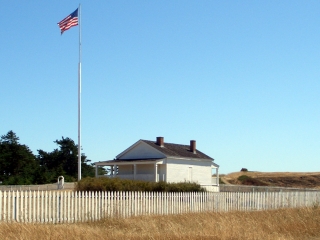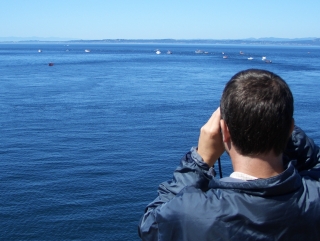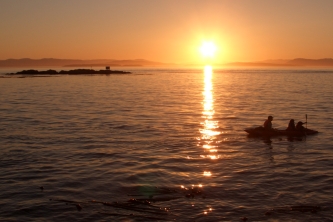San Juan Island, Wash.
NPS Website; Local Website
Site of a prolonged bloodless border conflict, 1853-72, between the United States and Great Britain.
BEAUTY (9/10)
The deep blue waters of the Haro Strait and the Strait of Juan de Fuca surround the Island with a glorious shimmer, Canada’s Vancouver Island makes a beautiful western horizon. While driving on a breathtaking coastline road to the American Camp, we saw a gathering of boats on the water and a crowd of people on land. Piercing through the water were the tall sharp black fins of killer whales. We stared as dozens frolicked below, some in large groups some solitary.
The rocky cliff’s along road linking the two Camps is the best spot in the continental U.S. to spot Orcas. We were not disappointed. While at the American Camp, another majestic sea animal appeared overhead: a soaring juvenile Bald Eagle; its nest is located just across from the Visitor Center.
The American Camp’s stark Strait-bordering yellow landscape is in sharp contrast to the lush Harbor-bordering green Eden of the British Camp. Trees bloom and a manicured ceremonial garden bursts with all the colors of the rainbow.
HISTORICAL INTEREST (4/10)
The British Hudson Bay Trading Company, the venerable fur powerhouse, effectively controlled the Pacific Northwest for much of the early 1800’s but by the 1840’s the feisty American people, swept up in the fever of Manifest Destiny, marched westward claiming the land to be theirs. The Oregon Treaty of 1846 gave the U.S. the land south of the 49th parallel (the current U.S.-Canada border) but was unclear as to who owned the string of islands west of mainland Washington, collectively known as the San Juans.
In June of 1859, an American settler on San Juan Island shot a Hudson Bay Company pig. The swine was trespassing, you see. Cooler heads did not prevail. By August, the Americans had brought 461 soldiers and 14 cannons while the British countered with 2,140 troops and five warships. No one wanted to start a war so both countries remained entrenched, 13 miles apart on a small island, until 1872 when Germany’s Kaiser Wilhem independently interpreted the Oregon Treaty, giving the land to the U.S. Yes, good work Kaiser!
During their stay on the Island the opposing soldiers often interacted, establishing friendships, racing horses against each other and attending weddings. We find it unlikely that a third U.S.-Great Britain war could have occurred over a pig but stranger things have happened. On the other hand, we did win the first two wars and everyone says British Columbia is very beautiful. Hmmmm, what if?
CROWDS (7/10)
Both camps were modestly full with browsing tourists. No one seemed particularly interested in the Site’s history; they were just looking for something touristy to do.
The Park is on an island, accessible from the United States only via the Washington State Ferry that leaves from Anacortes, Wash. Since the two Camps are 13 miles apart, you need transportation. $47 gets you and your car from Anacortes to Friday Harbor and back to Anacortes. Each additional passenger is $12. Prices change. Thankfully, the Washington State Ferries website has a helpful fare calculator.
There are not many roads on San Juan Island and only one sizable town. American Camp is at the Island’s southeastern tip and English camp in the northwest. Pick up a map in Friday Harbor and you will be fine.
CONCESSIONS/BOOKSTORE (3/5)
The Site carries only three books and one pamphlet, entitled The Pig That Loved Potatoes, which revolve around the border dispute. Most of the titles discuss San Juan Islands wildlife, specifically killer whales. The bookstore also sells stuffed animal dolls; Gab especially liked the stuffed elk back pack and the furry orca.
COSTS (1/5)
Entry into both the American and English Camps is free. The ferry is not.
RANGER/GUIDE TO TOURIST RATIO (2/5)
No Rangers at either Camp, just helpful volunteers.
TOURS/CLASSES (4/10)
We missed the Ranger-led programs; they take place only on summer weekends. Both Camps show the same intro video. The British Camp’s theater sits in the restored barracks building has ample seating and a large projection screen. The American Camp shows the video on a 15” TV wedged in a corner of its small visitor center. Watch the video at the British Camp; you will not be able to concentrate at the American Camp.
The Visitor Centers at both camps provide handy self-guided walking tour booklets. Use and return the booklet or purchase it as a memento for $1. Pick one up. While they may be a little dry, they do explain the Camps’ history.
FUN (9/10)
Admittedly, the Historical Park is not what makes San Juan Island fun, that would be the Orcas. And, oh my, did we have a great time spotting those intelligent black and white beasts. Our hearts raced when we saw just one spire-like fin. The more we saw the more uncontrollable our giddiness. Dozens swam in front of our perfect cliff side perch.
Michael’s naturalist cousin confirmed that the best place to the San Juan’s killer whales is from the cliffs and not from the myriad tourist boats. “You see them all,” he explained “and you do not stress them. One of these days, I think, the orcas are going to leave those waters so they can swim in peace.”
Let’s hope not, but until then whale watching on San Juan Island makes for a perfect day. Did we mention the ideal summer climate, the Bald Eagles and the inspirational scenery? Learning about the silly Pig War is a pleasant way to spend a few hours between whale watching and dining in Friday Harbor.
Would you believe we almost didn’t go? For some reason, we convinced ourselves that the ferry crossing was much more expensive than it actually was, and that services on San Juan Island were primitive at best. A quick trip to the ferry terminal and a glance at one of several Visit San Juan! tourist magazines that filled our Anacortes motel’s lobby proved us wrong.
Although the San Juan Island NHP was not the highlight of our overnight trip, had it not been our destination, we may have never ventured on to San Juan Island. That would have been a shame.
TOTAL 48/80
www.usa-c2c.com
© 2004-06